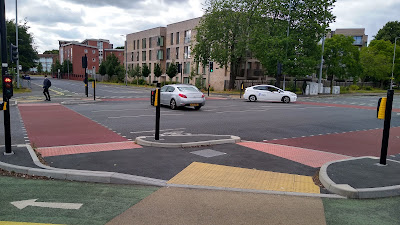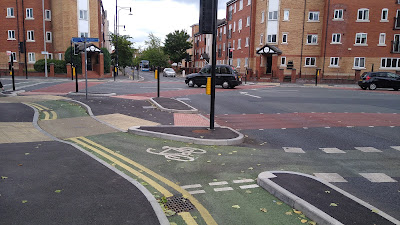At long last, I have manged to get out to go and experience the CYCLOPS junctions which are starting to be rolled out across the UK.
I have covered the Cycle Optimised Protected Signals junction designs before with a comparison with the Dutch approach and I have seen plenty of photographs and videos of the design. However, there's nothing like seeing infrastructure in the flesh and so in this post, I will have a look at the first and third examples of the arrangement which were built in Manchester.
First, let's have a little recap. The sketch above is a general arrangement of the CYCLOPS junction. The red shows a series of cycle tracks and in this case, they are all with flow. This means that cycle traffic circulates around the junction in a clockwise fashion. The light grey is footway and island areas and the dark grey is the carriageway. You'll notice the mini-zebra crossings over the cycle track which in this case are placed on small speed humps and the dark red is tactile paving.
The 'L' shaped tactile paving essentially shows the start and end point of a complete crossing of the junction and personally, I prefer this to leaving the cycle track crossings uncontrolled. The little speed humps are not about slowing cycle traffic, they are more around giving a level crossing point. Some visually impaired users do prefer having dropped kerbs as the slopes help show they are entering a crossing area.
In terms of guidance, Local Transport Note 1/20 "Cycle Infrastructure Design" uses a catch-all term of Circulating Cycle Stage Junction in S10.6.21 for signalised junctions where walking and cycling run together orbitally around an entire junction of which CYCLOPS is a style. It is possible to use two-way cycle tracks with the design, but I'll cover that another time.
Probably down to timing of publication, but LTN1/20 doesn't include a CYCLOPS junction, and the section on circulating stage junctions is very brief for what, in my view, is going to become a very important design tool in the coming years - as an aside, LTN1/20 doesn't go into enough detail on design generally, but that's another post. Here's a more detailed technical document explaining the concept.
The first CYCLOPS junction was delivered in 2020 on the Manchester to Chorlton Cycleway at the junction of the A5067 Chorlton Road and Royce Road (above). In the photograph above you can see one of four pedestrian islands on the left (one at each corner) with the pedestrian crossing in red. On the right of that, there is a the one-way cycle crossing (green) running in parallel.
Above is a slightly different view of the junction, this time showing more of the corner island and the traffic signals. Transport for Greater Manchester has elected to use a pair of low level cycle signals - personally I like to see a full-sized signal plus a low level sign with the former being more easily seen from a distance back. There is a push button, but that's a back-up because there is detection and it's too close to the stop line for my liking (coming at it from a non-standard cycle user's perspective. It is nice to see the button light up to show you are detected.
For pedestrians, there is no priority onto/ off from the island and I personally would have preferred a mini-zebra crossing. The island is quite complicated as it is really three small islands forming a larger space which sits at carriageway level and the further island (in the middle of the three in the photograph above) helps to keep left turning drivers out wide.
The islands provide a vertical upstand to help cane-users to navigate, but they create a problem for wheelchair and mobility scooter users who cannot get close to the push button. A better approach would have been to place the posts at the same level as the walking surface.
Because the access to the island is not in line with the signalised crossing of the road, people have to turn through 45° to move between the crossing points. This means that it is less likely that visually impaired people will mistake the crossings as single movement as can be the concern with in-line crossings. This is something DfT worries about in LTN1/20 (10.6.22) where mini-zebras are used with signals over the road, although I think this is overstated to some extent. However, it address some issues, so I am not against it.
The other design decision was to provide a gap in the approaching cycle track protection to allow cycle traffic to move out of the cycle track into general traffic, complete with an advanced stop line (ASL). This means that some cyclists may elect to move into traffic if the signals are showing in favour if that movement. The photograph above shows someone who has chosen to do this.
This was the first CYCLOPS and so there was concern that people cycling wouldn't want to wait for a green signal, so the access to the ASL was an adjustment to counter the problem. The real problem of course is how much time we give to general traffic verus how nimble and efficient cycling is given that the CYCLOPS junction is motoring infrastructure. The signals engineers have been tweaking the detection and so it isn't a huge issue and in theory, the all round green for walking and cycling could be run twice per cycle.
225 metres south of the first CYCLOPS, we have the UK's third, which is part of the same scheme, this time at the junction of Chortlon Road with the A5067 Stretford Road.
In many ways, it's the same layout as the first, but an immediate difference is the addition of a diagonal pedestrian crossing between the southeast and northeast islands (above). The junction is skewed which means one of the diagonals is quite short and because walking and cycling run under a single green, the diagonal is easy to accommodate. In fact, had the junction been designed in the Dutch way with the cycles on the inside, then the diagonal wouldn't have been possible.
The walking layout on the diagonal islands is a little more complicated with two crossings of the cycle tack each, but as things are offset as with the first scheme, it all works very intuitively. There are no ASLs on this scheme, but there are gaps in the kerb protection if one feels the need to move out. When I cycled the two junctions I didn't have to wait too long and as you'll see in the video below, a complete U-turn is easily possible within the green which is a very important feature to allow people to change direction if they didn't want to cross the road to turn right at a proceeding junction.
The CYCLOPS junction is interesting because on the face of it, we get fully protected intersections which feels very familiar to anyone who has used such in other places, especially northern europe. However, at the same time, they are very much British and have a look and feel that will be familiar to politicians and designers (including signals engineers) as well as the public and that is why we'll see them all of the UK in the coming months and years.
Overall, I think the cycle tracks are a touch narrow, there are perhaps too many fiddly kerbs and islands, and the colour scheme is a bit garish, but the junctions work well and most importantly, they give a great sense of protected and action protection from traffic.
I'll leave you with a video of a bit of cycling in the general area, including these two new junctions.








No comments:
Post a Comment